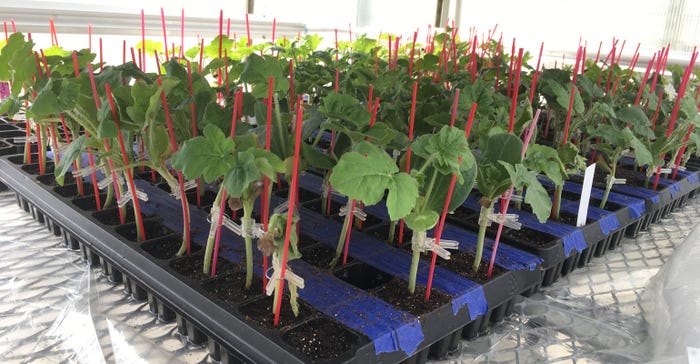September 3, 2020

Any farmer knows nature is at work to reduce crop yields. One big challenge is crop diseases that are difficult to defeat and often occur in high-value crops. Washington State University researchers are at work on the challenge with two crops — watermelons and cherries.
Grafting and watermelons
A new study from the WSU Department of Horticulture has found that splice-grafting helps watermelons resist verticillium wilt. The findings were published recently in the journal for the American Society for Horticulture Science.
Growers have been struggling against wilt, caused by the fungus Verticillium dahliae, for more than a decade. For decades, farmers used methyl bromide as a fumigant to control pests and diseases, including verticillium. But the crop protection product was phased out in 2005.
Carol Miles, interim director of the Northwestern Washington Research and Extension Center in Mount Vernon, notes, “When methyl bromide was disallowed, farmers no longer had access to it, which meant they had less control over disease spread.” Miles led a study to look for an alternative.
That search included looking overseas to markets that had walked away from methyl bromide years before. “What many of the growers were doing was grafting,” Miles says. This technique, common in other crops like grapes, involves joining two plants so they grow as a single plant. The upper part, or scion, of one plant grows with the root system, or rootstock, of another.
The idea of grafting watermelon isn't new; the Japanese have been doing it for more than 100 years, Miles says. As a professor in the Department of Horticulture, Miles, along with her team, experimented with grafted and nongrafted watermelon plants. The healthy rootstock resistant to verticillium wilt that was used on the watermelon plants is from squash plants.
 GRAFTING SUCCESS: These watermelon plants at the WSU Mount Vernon Northwest Research and Extension Center are thriving after being grafted to squash rootstock. It’s an approach that may help protect against verticillium wilt.
GRAFTING SUCCESS: These watermelon plants at the WSU Mount Vernon Northwest Research and Extension Center are thriving after being grafted to squash rootstock. It’s an approach that may help protect against verticillium wilt.

“The study revealed that we can produce grafted watermelon crop yields that are better than nongrafted plants when there is disease pressure,” she says. Nongrafted plants died during the study, but grafted plants survived.
And how do those grafted watermelons taste? Miles reports that the fruit from the grafted watermelons is as good, “and in some cases, better, than nongrafted fruit.”
And there’s an added benefit for this work. “Having a grafting industry here in western Washington would be a great benefit,” Miles says. She points out that purchasing rootstocks from countries abroad isn’t always convenient.
Tackling a cherry disease
Scientists at WSU have teamed with cherry growers to find improved defenses against a disease that devastated orchards 70 years ago and has resurfaced in the Pacific Northwest.
Named for its unpalatable symptoms — small, insipid, colorless fruit — little cherry disease encompasses several pathogens that infect sweet cherries and other stone fruit trees. In Washington and Oregon, the main culprit is a bacterial pathogen called X-disease phytoplasma, which is spread through orchards by small insects called leafhoppers. Symptoms are usually noticed only a few weeks before harvest.
Notes Scott Harper, WSU virologist and director of the Clean Plant Center Northwest, based in Prosser, Wash.: “You get no warning. Everything looks fine, and suddenly things are not fine.”
And once infected, there is no remedy other that speedy removal of sick trees to slow transmission.
The disease has a repeating cycle. It popped up in the 1940s and early 1950s, only to be stopped by aggressive destruction of infected trees. A smaller outbreak hit in the 1980s.
Now the cycle is repeating, with reports of little cherry disease rising since 2017, and it is again a concern for Northwest cherries.
Scientists at WSU and Oregon State University, cherry growers and processors and other partners formed the Little Cherry Disease Task Force in 2018 to coordinate research. Tobin Northfield, an entomologist based at the WSU Tree Fruit Research and Extension Center in Wenatchee, chairs the task force.
“If we do nothing, this disease will have a huge impact on our ability to grow cherries,” Northfield says. “We’re trying to find effective controls as quickly as we can.”
Building on discoveries made during past outbreaks, scientists are seeking to identify important plants in the environment that harbor the little cherry pathogen. While leafhoppers and annual plants die every winter, perennial plants don’t.
Northfield adds that removing trees is critical since they link one year to the next. “But perennial weeds may also be doing the same thing,” he says. Task force scientists are performing food choice tests on captive leafhoppers to learn which plants they prefer. Results could help orchardists remove plants and weeds that harbor the pathogen.
Tactics being reviewed range from spraying kaolin clay as a leafhopper deterrent to using white plastic ground covers as a barrier for leafhoppers. The plastic has the added benefit of retaining moisture and reflecting light, which can help lighter-color cherry varieties develop an attractive blush color. And cherry varieties that may be resistant to the disease are being researched as well.
Northfield says that little cherry disease is a complicated problem that an entomologist or plant pathologist can't handle alone. “That’s the advantage of bringing the task force together. We can beat this disease, but it’s going to take a lot of effort by everyone involved to protect Northwest cherries and keep them on our plates.”
Source: Washington State University, which is solely responsible for the information provided and is wholly owned by the source. Informa Business Media and all its subsidiaries are not responsible for any of the content contained in this information asset.
You May Also Like




